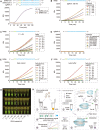Can CRISPR/Cas Technology Be a Felicitous Stratagem Against the COVID-19 Fiasco? Prospects and Hitches
- PMID: 33134311
- PMCID: PMC7511716
- DOI: 10.3389/fmolb.2020.557377
Can CRISPR/Cas Technology Be a Felicitous Stratagem Against the COVID-19 Fiasco? Prospects and Hitches
Abstract
The current global debacle of COVID-19, spelled by SARS-CoV-2 needs no elaboration. With incessant and constantly clambering number of deaths across various nations, the need of the hour is to develop readily deployable, fast, affordable detection assays and kits, yielding precise and consistent results as well as timely availability of efficacious anti-SARS-CoV-2 strategies to contain it. Conventionally employed real time PCR based technique for detection of the virus suffers from a couple of handicaps. Amongst other approaches, CRISPR based technology has ushered in new hopes. Recent efforts have been directed toward developing CRISPR/Cas based low-cost, rapid detection methods as well as development of one-pot assay platforms. The plausible application of CRISPR-Cas system to counteract the viral assault has also been assessed. The write up in this article mirrors the current status, the prospects and the practical snags of CRISPR/Cas technology for the detection and inactivation of the novel corona virus, SARS-CoV-2.
Keywords: COVID-19; CRISPR/Cas; RNA; SARS-CoV-2; diagnostics; viral inactivation.
Copyright © 2020 Konwarh.
Figures


Similar articles
-
A thermostable Cas12b from Brevibacillus leverages one-pot discrimination of SARS-CoV-2 variants of concern.EBioMedicine. 2022 Mar;77:103926. doi: 10.1016/j.ebiom.2022.103926. Epub 2022 Mar 13. EBioMedicine. 2022. PMID: 35290826 Free PMC article.
-
CRISPR/Cas-New Molecular Scissors in Diagnostics and Therapeutics of COVID-19.Indian J Clin Biochem. 2021 Oct;36(4):459-467. doi: 10.1007/s12291-021-00977-y. Epub 2021 Apr 16. Indian J Clin Biochem. 2021. PMID: 33879980 Free PMC article. Review.
-
CRISPR detectives against SARS-CoV-2: a major setback against COVID-19 blowout.Appl Microbiol Biotechnol. 2021 Oct;105(20):7593-7605. doi: 10.1007/s00253-021-11583-6. Epub 2021 Sep 20. Appl Microbiol Biotechnol. 2021. PMID: 34542686 Free PMC article. Review.
-
Development and Validation of a Novel COVID-19 nsp8 One-Tube RT-LAMP-CRISPR Assay for SARS-CoV-2 Diagnosis.Microbiol Spectr. 2022 Dec 21;10(6):e0196222. doi: 10.1128/spectrum.01962-22. Epub 2022 Nov 29. Microbiol Spectr. 2022. PMID: 36445095 Free PMC article.
-
CRISPR-Cas system: A promising tool for rapid detection of SARS-CoV-2 variants.J Med Virol. 2024 Jan;96(1):e29356. doi: 10.1002/jmv.29356. J Med Virol. 2024. PMID: 38180237 Review.
Cited by
-
Molecular and antigen tests, and sample types for diagnosis of COVID-19: a review.Future Virol. 2022 Jun;17(9):675-85. doi: 10.2217/fvl-2021-0256. Epub 2022 Jul 1. Future Virol. 2022. PMID: 35783674 Free PMC article. Review.
-
Exploring nano-enabled CRISPR-Cas-powered strategies for efficient diagnostics and treatment of infectious diseases.J Nanostructure Chem. 2022;12(5):833-864. doi: 10.1007/s40097-022-00472-7. Epub 2022 Feb 14. J Nanostructure Chem. 2022. PMID: 35194511 Free PMC article. Review.
-
Nano-therapeutic strategies to target coronavirus.View (Beijing). 2021 Jun;2(3):20200155. doi: 10.1002/VIW.20200155. Epub 2021 Mar 9. View (Beijing). 2021. PMID: 34766165 Free PMC article. Review.
-
3Bs of CRISPR-Cas mediated genome editing in plants: exploring the basics, bioinformatics and biosafety landscape.Physiol Mol Biol Plants. 2023 Dec;29(12):1825-1850. doi: 10.1007/s12298-023-01397-3. Epub 2023 Dec 7. Physiol Mol Biol Plants. 2023. PMID: 38222286 Free PMC article. Review.
-
Conventional and Novel Diagnostic Tools for the Diagnosis of Emerging SARS-CoV-2 Variants.Vaccines (Basel). 2023 Feb 6;11(2):374. doi: 10.3390/vaccines11020374. Vaccines (Basel). 2023. PMID: 36851252 Free PMC article. Review.
References
-
- Al Jazeera and News Agencies (2020). India’s Poor Testing Rate May Have Masked Coronavirus Cases. Available online at: https://www.aljazeera.com/news/2020/03/india-poor-testing-rate-masked-co... (Accessed June 23, 2020)
LinkOut - more resources
Full Text Sources
Miscellaneous

